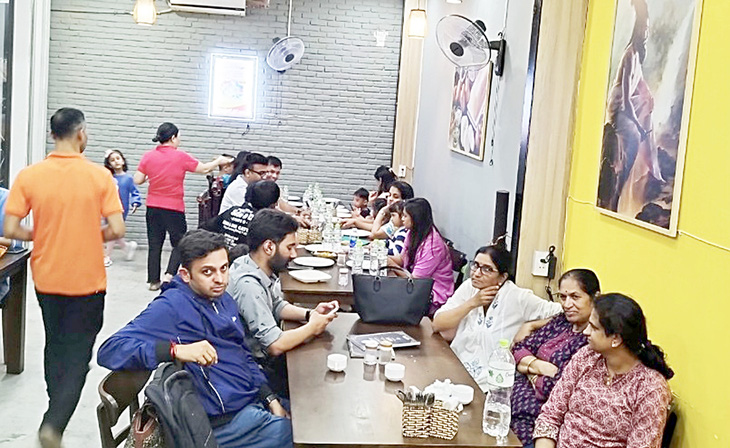Amid an increase in the number of Indian travelers to Da Nang in central Vietnam, the coastal city should invest in restaurants and hotels which can offer dishes and prayer spaces to meet Indian tourists’ demands.
After surveying Da Nang and some other cities in Vietnam for two weeks, Vipin Nain, director of Nain Vacations, a travel company located in India, and some Indian travel firms affirmed Da Nang is an attractive destination in Asia with multiple advantages.
For Indian tourists, Da Nang has three advantages: beautiful river and sea landscapes, professional tourism development plans, and the Da Nang Museum of Cham Sculpture.
“Beaches lined with many beautiful hotels will attract high-end tourists from India, especially groups who want to hold wedding parties and other important events," Nain said.
“Moreover, the Da Nang Museum of Cham Sculpture is a typical cultural and historical site for Indian tourists.
"We believe that the city will see a boom in the number of Indian tourists with more direct air routes being launched."
At present, there are three direct air routes between Da Nang and India’s New Delhi, Mumbai, and Ahmedabad, operated by Vietnam’s low-cost air carrier Vietjet Air from October last year with a frequency of 12 flights per week.
Over the past three months, more than 20,000 Indian travelers have visited Da Nang, making India the fifth-largest source market for Da Nang’s tourism, following South Korea, Thailand, the U.S., and Malaysia.
Since early last year, nearly 39,400 Indian tourists have stayed in Da Nang, nearly 2.5 times over 2019, contributing to diversifying international tourists coming to the central coastal city.
Demanding requirements for cuisine, prayer spaces
According to travel companies, Indian tourists are generous and pliant. However, they are picky in food, beverages, and religious practices.
For example, an Indian family who chose Da Nang as the venue for a wedding party during the Lunar New Year, or Tet, holiday last month. Although there were only over 350 guests, the event organizer had to mobilize upwards of 100 employees and chefs and some two metric tons of materials, clothes, and equipment from India to serve the party.
Satish Ramnani, director of Veydaa Events, the organizer of the above-mentioned wedding party, said the company will organize two more wedding parties in Da Nang.
“Da Nang has advantages in high-end lodging facilities to become an attractive venue for wedding parties of wealthy Indian families,” Ramnani added.
Generous Indian travelers are expected to help fetch large revenue for Da Nang. However, Indian restaurants in the city are rare.
Notably, there are even fewer that meet Halal standards, which stipulate requirements for food products and services served to Muslims.
Janardhan, the owner of Indian Curry-Da Nang restaurant, which has operated for four years in Son Tra District, Da Nang, said besides experiencing dishes of other regions, many Indian tourists are loyal to their traditional dishes and religious practices.
Indian visitors can be divided into three groups: Hindus, vegetarians, and Muslims.
Of these, Muslim tourists always request restaurants to show Halal certificates, which prove that their products and services meet Muslim requirements.
Meanwhile, Indian vegetarians and Hindus need private spaces to enjoy meals.
Chatur, an Indian traveler, said many Indian tourists even bring food with them as they cannot set their mind at rest with dishes in other countries.
Therefore, satisfying Indian tourists’ demands will help attract them.
Tourism service providers in Da Nang should pay more attention to Indian cuisine, Nain recommended.
They should invest in infrastructure and manpower to better serve Muslims and Indian guests as a whole.
Indian tourists tend to spend long stays with an average period of five to seven days in a destination. If the destination’s food fails to satisfy these tourists, it will be hard to retain them.
According to Luong Van Trang, director of the Inbound Division at Vietnam TravelMART JSC, a travel company, given an increase in the number of Indian travelers, restaurants in Da Nang are incapable of serving them, especially MICE (meetings, incentives, conferences, and exhibitions) tourists and guests of wedding parties.
As a result, local travel companies have to hire chefs from India to service their customers.
“This is a country with a large population, while Vietnam is preferable in India, so the cooperation between agencies at higher levels in training human resources, specifically chefs, and in simplifying visa policies is needed,” Trang noted.
Nguyen Thi Hoai An, director of the Da Nang Tourism Promotion Center, said the city has held tourism promotion programs and seminars to lure Indian tourists, focusing on their food and religious practice demands.
Da Nang plans to set aside a space at its airport to make a room for prayers and encourages lodging facilities to pay more attention to Indian cuisine.
Like us on Facebook or follow us on Twitter to get the latest news about Vietnam!


















































